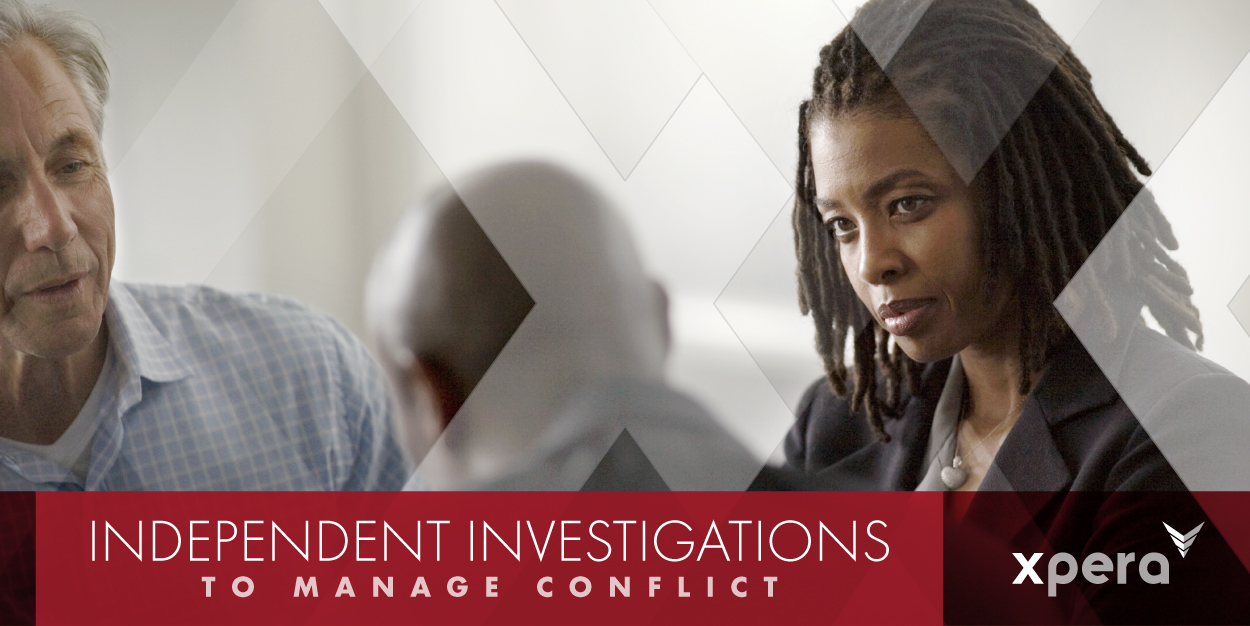
By: Xpera Risk Mitigation & Investigation
xpera.ca
Leverage the insight of an independent workplace investigation
Conflict in the workplace can arise due to harassment, bullying, abuse of authority, discrimination or a variety of other reasons.
To address and resolve the situation, it’s imperative that an impartial investigation takes place.
One way to ensure that it’s as objective as possible, is by contracting an experienced, independent firm to conduct the enquiry.
How an independent firm ensures an equitable investigation
The aim of an independent investigator conducting a workplace enquiry is to gather information in an unbiased manner. This allows them to develop an understanding of the workplace’s culture and related dynamics so they can identify the root cause(s) of the conflict and issues.
The integrity of a workplace investigation must always be preserved. To do this, the investigator approaches the investigation with an open mind and without predeterminations regarding the complainant or situation. They also ensure procedural fairness by following all employer policies and procedures. Most importantly, the confidentiality and privacy of all parties involved is guarded to protect against potential retaliation toward the complainant, respondent, witnesses and others.
When the investigation is complete, the investigator will provide a thorough report. It will summarize the relevant documents and evidence reviewed, the interviews conducted, and present the findings in an objective, unbiased, fact-based manner to ensure they will stand up to any scrutiny.
What you’ll need to provide the investigator
To carry out a comprehensive investigation, an investigator will require detailed information regarding the incident. This includes an outline of the issues that led to the investigation, and the exact nature of the incident.
Supporting documentation is also necessary. Here’s what you’ll need to provide the investigator:
- Workplace Harassment and Violence policies
- Respectful Workplace policies and Code of Conduct policies
- Collective Agreement information (if applicable)
- Company complaint process
- Names, roles and contact Information of the involved parties
- Employment details of all parties involved
- Incident reports
- Written statements and/or complaints
- Written witness accounts
- Responses made by management and/or legal counsel if any
- Documentation relating to previous incidents of potential relevance
- Video recordings
- Access to control data and any other relevant digital evidence
- Specific instructions on how to engage the parties
The investigator may also request to review locations and sites that are deemed relevant to the investigation.
The 7 Steps of a Workplace Investigation
1. Consultation with point of contact
After reviewing the supporting documents, the investigator will consult with the client point of contact to get an understanding of the work environment in which the investigation is taking place. In addition, letters will be sent to the complainant(s) and respondent(s) to confirm that an investigation is underway and they will be contacted to arrange an interview.
2. Interview of complainant(s)
The complainant(s) will be asked by the investigator to recount the incidents and/or ongoing actions or behaviour that are the basis for their allegation(s). The interview is recorded in the event the investigator’s account of an interview is later questioned.
3. Interview of witnesses
Witnesses will be asked by the investigator to provide their recollection of the incidents and/or ongoing behaviour, and to comment on any other relevant behaviour of concern on the part of the respondent(s).
4. Interview of respondent(s)
Respondents will be asked by the investigator to provide their recollections and interpretation of the alleged behaviour and incidents that are the reason for the allegations.
5. Additional interviews
If new information comes to light the investigator may need to interview additional witnesses or conduct follow-up interviews with the complainant(s), previous witnesses and/or respondent(s).
6. Generation of findings
The investigator reviews the documents supplied and the content gathered via the interviews to determine the factual findings of their investigation.
7. Creation and presentation of the report
The report will summarize the documents and evidence reviewed, the interviews conducted, and the findings of the investigation. Once the report is complete the report is presented by the investigator to the client representative.
An independent workplace investigation gives you peace of mind
Having to deal with a workplace conflict is never easy. The well being of those involved and, potentially, their employment is on the line. Knowing that whatever decision you make is based on the findings of an independent and unbiased workplace investigation will allow you to feel confident you have taken the right course of action.
Presented by

Archives
Categories
- Attraction and Recruitment
- Benefits
- Celebrating Success and Recognition
- Change Management
- Coaching and Conflict Resolution
- Culture
- Diversity, Equity and Inclusion
- Emotional Intelligence
- Employee Engagement
- Employee Performance
- Labour Disruption
- Mentoring
- OMHRA activities
- OMHRA Events
- Psychological health and safety of the HR professional
- Recruitment
- Recruitment and Retention
- Retention
- Uncategorized
- Unique ideas for recruiting in a tight job market
- Wellness
Recent Posts
- How Leadership Development Coaching Provides Better Outcomes
- Better Leadership: Focus on a Coach Approach
- Creating a Psychologically Safe Workplace
- Group Health Insurance – The Impact of Preferred Pharmacy Networks on Employees’ Mental Health
- Provide Real Support For Your Mid-Career Team’s Psychological Resilience
